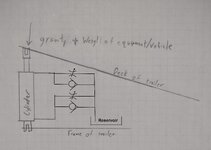I'm trying to design a very simple hydraulic circuit. Currently the hydraulic cylinder has capped in/out flow, and only acts as a cushion for a tilt deck trailer. I need to stop flow while a load is driven/pulled onto the trailer. Is there any reason I can't just place a needle valve in between the in/out flow ports, with hoses, to stop flow? I've seen other systems that use a reservoir. Is the reservoir needed or am I missing something?
I understand that the current cylinder has a relief hole in the piston. For my purposes I am planning on using a cylinder without the relief hole.
I understand that the current cylinder has a relief hole in the piston. For my purposes I am planning on using a cylinder without the relief hole.
Last edited:



